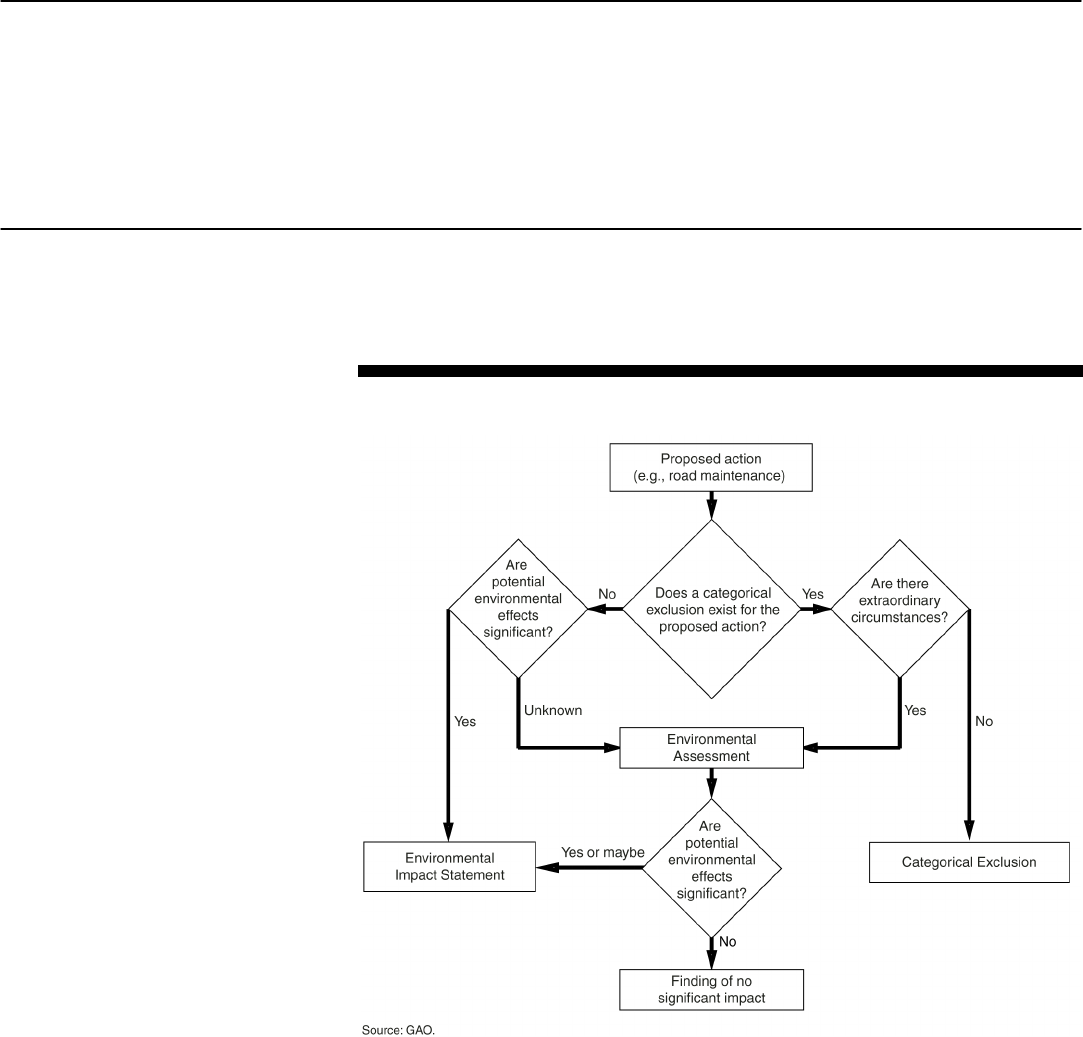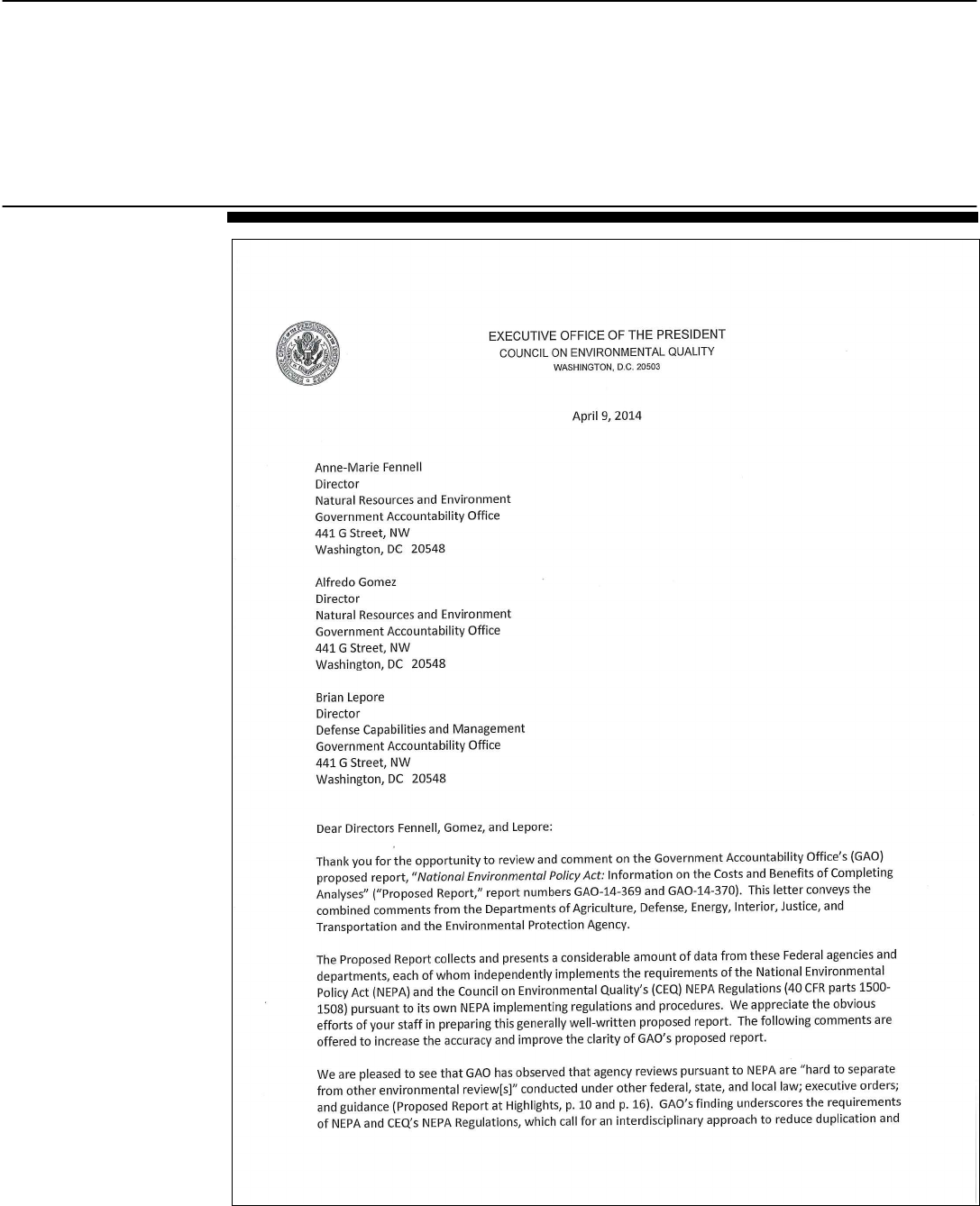
NATIONAL
ENVIRONMENTAL
POLICY ACT
Little Information
Exists on NEPA
Analyses
Report to Congressional Requesters
April 2014
GAO-14-369
United States Government Accountability Office

United States Government Accountability Office
Highlights of GAO-14-369, a report to
congressional requesters
April 2014
NATIONAL ENVIRONMENTAL POLICY ACT
Little Information Exists On NEPA Analyses
Why GAO Did This Study
NEPA requires all federal agencies to
evaluate the potential environmental
effects of proposed projects—such as
roads or bridges—on the human
environment. Agencies prepare an EIS
when a project will have a potentially
significant impact on the environment.
They may prepare an EA to determine
whether a project will have a significant
potential impact. If a project fits within
a category of activities determined to
have no significant impact—a CE—
then an EA or an EIS is generally not
necessary. The adequacy of these
analyses has been a focus of litigation.
GAO was asked to review issues
related to costs, time frames, and
litigation associated with completing
NEPA analyses. This report describes
information on the (1) number and type
of NEPA analyses, (2) costs and
benefits of completing those analyses,
and (3) frequency and outcomes of
related litigation. GAO included
available information on both costs and
benefits to be consistent with standard
economic principles for evaluating
federal programs, and selected the
Departments of Defense, Energy, the
Interior, and Transportation, and the
USDA Forest Service for analysis
because they generally complete the
most NEPA analyses. GAO reviewed
documents and interviewed individuals
from federal agencies, academia, and
professional groups with expertise in
NEPA analyses and litigation. GAO’s
findings are not generalizeable to
agencies other than those selected.
This report has no recommendations.
GAO provided a draft to CEQ and
agency officials for review and
comment, and they generally agreed
with GAO’s findings.
What GAO Found
Governmentwide data on the number and type of most National Environmental
Policy Act (NEPA) analyses are not readily available, as data collection efforts
vary by agency. NEPA generally requires federal agencies to evaluate the
potential environmental effects of actions they propose to carry out, fund, or
approve (e.g., by permit) by preparing analyses of different comprehensiveness
depending on the significance of a proposed project’s effects on the
environment—from the most detailed Environmental Impact Statements (EIS) to
the less comprehensive Environmental Assessments (EA) and Categorical
Exclusions (CE). Agencies do not routinely track the number of EAs or CEs, but
the Council on Environmental Quality (CEQ)—the entity within the Executive
Office of the President that oversees NEPA implementation—estimates that
about 95 percent of NEPA analyses are CEs, less than 5 percent are EAs, and
less than 1 percent are EISs. Projects requiring an EIS are a small portion of all
projects but are likely to be high-profile, complex, and expensive. The
Environmental Protection Agency (EPA) maintains governmentwide information
on EISs. A 2011 Congressional Research Service report noted that determining
the total number of federal actions subject to NEPA is difficult, since most
agencies track only the number of actions requiring an EIS.
Little information exists on the costs and benefits of completing NEPA analyses.
Agencies do not routinely track the cost of completing NEPA analyses, and there
is no governmentwide mechanism to do so, according to officials from CEQ,
EPA, and other agencies GAO reviewed. However, the Department of Energy
(DOE) tracks limited cost data associated with NEPA analyses. DOE officials told
GAO that they track the money the agency pays to contractors to conduct NEPA
analyses. According to DOE data, its median EIS contractor cost for calendar
years 2003 through 2012 was $1.4 million. For context, a 2003 task force report
to CEQ—the only available source of governmentwide cost estimates—
estimated that a typical EIS cost from $250,000 to $2 million. EAs and CEs
generally cost less than EISs, according to CEQ and federal agencies.
Information on the benefits of completing NEPA analyses is largely qualitative.
According to studies and agency officials, some of the qualitative benefits of
NEPA include its role in encouraging public participation and in discovering and
addressing project design problems that could be more costly in the long run.
Complicating the determination of costs and benefits, agency activities under
NEPA are hard to separate from other required environmental analyses under
federal laws such as the Endangered Species Act and the Clean Water Act;
executive orders; agency guidance; and state and local laws.
Some information is available on the frequency and outcome of NEPA litigation.
Agency data, interviews with agency officials, and available studies show that
most NEPA analyses do not result in litigation, although the impact of litigation
could be substantial if a single lawsuit affects numerous federal decisions or
actions in several states. In 2011, the most recent data available, CEQ reported
94 NEPA cases filed, down from the average of 129 cases filed per year from
calendar year 2001 through calendar year 2008. The federal government prevails
in most NEPA litigation, according to CEQ and legal studies.
View GAO-14-369. For more information,
contact Anne-Marie Fennell at (202) 512-3841
or

Page i GAO-14-369 National Environmental Policy Act
Letter 1
Background 3
Data on the Number and Type of Most NEPA Analyses Are Not
Readily Available 6
Little Information Exists on the Costs and Benefits of Completing
NEPA Analyses 10
Some Information Is Available on the Frequency and Outcome of
NEPA Litigation 18
Agency Comments and Our Evaluation 22
Appendix I Objectives, Scope, and Methodology 25
Appendix II Summary of Federal NEPA Data Collection Efforts 27
Appendix III CEQ NEPA Time Frame Guidelines 32
Appendix IV Sources of NEPA Litigation Data 33
Appendix V Comments from the Council on Environmental Quality 35
Appendix VI GAO Contacts and Staff Acknowledgments 37
Tables
Table 1: Number of Environmental Impact Statements from EPA,
CEQ, and NAEP, 2008 through 2012 8
Table 2: Number of Environmental Impact Statements by Agency
as Reported by National Association of Environmental
Professionals (NAEP), 2008 through 2012 10
Contents

Page ii GAO-14-369 National Environmental Policy Act
Figure
Figure 1: Process for Implementing National Environmental Policy
Act Requirements 4
Abbreviations
BLM Bureau of Land Management
CE Categorical Exclusion
CEQ Council on Environmental Quality
CRS Congressional Research Service
DOD Department of Defense
DOE Department of Energy
DOT Department of Transportation
eMNEPA electronic Management of NEPA
EA Environmental Assessment
EIS Environmental Impact Statement
EPA Environmental Protection Agency
FHWA Federal Highway Administration
NAEP National Association of Environmental Professionals
NEPA National Environmental Policy Act
PAPAI Project and Program Action Information
PEPC Planning, Environment, and Public Comment
This is a work of the U.S. government and is not subject to copyright protection in the
United States. The published product may be reproduced and distributed in its entirety
without further permission from GAO. However, because this work may contain
copyrighted images or other material, permission from the copyright holder may be
necessary if you wish to reproduce this material separately.

Page 1 GAO-14-369 National Environmental Policy Act
441 G St. N.W.
Washington, DC 20548
April 15, 2014
Congressional Requesters
The National Environmental Policy Act (NEPA)—the statute requiring
federal agencies to evaluate the potential environmental effects of
proposed projects on the human environment—has been identified by
critics as a cause of delay for projects because of time-consuming
requirements and praised by proponents for, among other things, bringing
public participation into government decision making.
1
Under NEPA, all
federal agencies generally are to evaluate the potential environmental
effects of actions they propose to carry out, fund, or approve (e.g., by
permit)—including the development of infrastructure projects, such as
roads and bridges. Enacted in 1970, NEPA, and the subsequent Council
on Environmental Quality Regulations Implementing the Procedural
Provisions of NEPA, set out an environmental review process that has
two principal purposes: (1) to ensure that an agency carefully considers
information concerning the potential environmental effects of proposed
development projects and (2) to ensure that this information is made
available to the public.
2
NEPA requires federal agencies to analyze the
nature and extent of a project’s potential environmental effects and, in
many cases, document these analyses.
3
1
NEPA applies to federal agency policies, programs, plans, and projects (40 C.F.R. §
1508.18(b)). The focus of this report is on development projects.
The documentation and
comprehensiveness of these analyses depends on the significance of a
project’s potential effects on the environment. The adequacy of NEPA
analyses has been a focus of litigation. You asked us to review various
2
Pub. L. No. 91-190 (1970), codified at 42 U.S.C. § 4321-4347. NEPA’s congressional
declaration of purpose states that the purposes of the act are “to declare a national policy
which will encourage productive and enjoyable harmony between man and his
environment; to promote efforts which will prevent or eliminate damage to the environment
and biosphere and stimulate the health and welfare of man; to enrich the understanding of
the ecological systems and natural resources important to the Nation; and to establish a
Council on Environmental Quality.” 42 U.S.C. § 4321.
3
The CEQ “Regulations for Implementing the Procedural Provisions of the National
Environmental Policy Act” (CEQ regulations), 40 C.F.R. Parts 1500-1508, set out the
levels of analysis and documentation for complying with NEPA. The level of analysis and
documentation can take the form of a Categorical Exclusion (CE), Environmental
Assessment (EA), or Environmental Impact Statement (EIS). Not all CEs are documented
at the time the CE is used for a specific proposed project.

Page 2 GAO-14-369 National Environmental Policy Act
issues related to costs, time frames, and litigation associated with
completing NEPA analyses. This report describes information on the (1)
number and type of NEPA analyses, (2) costs and benefits of completing
those analyses, and (3) frequency and outcomes of related litigation. We
included available information on both costs and benefits to be consistent
with standard economic principles for evaluating federal programs and
generally accepted government auditing standards.
To respond to these objectives, we reviewed relevant publications,
obtained documents and analyses from federal agencies, and interviewed
federal officials and individuals from academia and professional
associations with expertise in conducting NEPA analyses. Specifically, to
describe the number and type of NEPA analyses from calendar year 2008
through calendar year 2012 and what is known about the costs and
benefits of NEPA analyses, we reported information identified through the
literature review, interviews, and other sources. We selected the
Departments of Defense, Energy, the Interior, and Transportation; and
the Forest Service within the U.S. Department of Agriculture for analysis
because they generally complete the most NEPA analyses. Our findings
for these agencies are not generalizeable to other federal agencies but
provide examples of NEPA implementation. To describe the frequency
and outcome of NEPA litigation, we reviewed (1) laws, regulations, and
agency guidance; (2) NEPA litigation data collected from federal entities
and the National Association of Environmental Professionals (NAEP), the
professional association for NEPA practitioners within and outside the
federal government; and (3) relevant studies. To assess the reliability of
data collected from the selected agencies, we reviewed existing
documentation when available and interviewed officials, including those
from the U.S. Department of Justice, knowledgeable about the data. We
found all data to be sufficiently reliable for the purposes of this report. See
appendix I for additional details on our objectives, scope, and
methodology.
We conducted this performance audit from June 2013 to April 2014 in
accordance with generally accepted government auditing standards.
Those standards require that we plan and perform the audit to obtain
sufficient, appropriate evidence to provide a reasonable basis for our
findings and conclusions based on our audit objectives. We believe that
the evidence obtained provides a reasonable basis for our findings and
conclusions based on our audit objectives.

Page 3 GAO-14-369 National Environmental Policy Act
Under NEPA, federal agencies are to evaluate the potential
environmental effects of projects they are proposing by preparing either
an Environmental Assessment (EA) or a more detailed Environmental
Impact Statement (EIS), assuming no Categorical Exclusion (CE) applies.
Agencies may prepare an EA to determine whether a proposed project is
expected to have a potentially significant impact on the human
environment.
4
If prior to or during the development of an EA, the agency
determines that the project may cause significant environmental impacts,
an EIS should be prepared. However, if the agency, in its EA, determines
there are no significant impacts from the proposed project or action, then
it is to prepare a document—a Finding of No Significant Impact—that
presents the reasons why the agency has concluded that no significant
environmental impacts will occur if the project is implemented. An EIS is a
more detailed statement than an EA, and NEPA implementing regulations
specify requirements and procedures—such as providing the public with
an opportunity to comment on the draft document—applicable to the EIS
process that are not mandated for EAs.
5
If a proposed project fits within a category of activities that an agency has
already determined normally does not have the potential for significant
environmental impacts—a CE—and the agency has established that
category of activities in its NEPA implementing procedures, then it
generally need not prepare an EA or EIS.
6
4
The human environment is interpreted comprehensively to include the natural and
physical environment and the relationship of people to that environment (40 C.F.R. §
1508.14). The effects analyzed under NEPA include ecological, aesthetic, historic,
cultural, economic, social, or health (40 C.F.R. § 1508.8).
The agency may instead
approve projects that fit within the relevant category by using one of its
established CEs. For example, the Bureau of Land Management (BLM)
within the Department of the Interior (Interior) has CEs in place for
numerous types of activities, such as constructing nesting platforms for
wild birds and constructing snow fences for safety. For a project to be
5
An EIS must, among other things, (1) describe the environment that will be affected, (2)
identify alternatives to the proposed action and identify the agency’s preferred alternative,
(3) present the environmental impacts of the proposed action and alternatives, and (4)
identify any adverse environmental impacts that cannot be avoided should the proposed
action be implemented.
6
Some categorical exclusions are established by statute and therefore generally do not
require an agency determination that such actions do not have a significant environmental
impact.
Background

Page 4 GAO-14-369 National Environmental Policy Act
approved using a CE, the agency must determine whether any
extraordinary circumstances exist in which a normally excluded action
may have a significant effect. Figure 1 illustrates the general process for
implementing NEPA requirements.
Figure 1: Process for Implementing National Environmental Policy Act
Requirements
Private individuals or companies may become involved in the NEPA
process when a project they are developing needs a permit or other
authorization from a federal agency to proceed, such as when the project
involves federal land. For example, a company may apply for such a
permit in constructing a pipeline crossing federal lands; in that case, the
agency that is being asked to issue the permit must evaluate the potential
environmental effects of constructing the pipeline under NEPA. The
private company or developer may in some cases provide environmental
analyses and documentation or enter into an agreement with an agency
to pay a contractor for the preparation of environmental analyses and

Page 5 GAO-14-369 National Environmental Policy Act
documents, but the agency remains ultimately responsible for the scope
and content of the analyses under NEPA.
7
CEQ within the Executive Office of the President oversees the
implementation of NEPA, reviews and approves federal agency NEPA
procedures, and issues regulations and guidance documents that govern
and guide federal agencies’ interpretation and implementation of NEPA.
8
The Environmental Protection Agency (EPA) also plays two key roles in
other agencies’ NEPA processes. First, EPA reviews and publicly
comments on the adequacy of each draft EIS and the environmental
impacts of the proposed actions reviewed in the EIS. If EPA determines
that the action is environmentally unsatisfactory, it is required by law to
refer the matter to CEQ. Second, EPA maintains a national EIS filing
system. Federal entities must publish in the Federal Register a Notice of
Intent to prepare an EIS and file their draft and final EISs with EPA, which
publishes weekly notices in the Federal Register listing EISs available for
public review and comment.
9
CEQ’s regulations implementing NEPA require federal agencies to solicit
public comment on draft EISs.
10
When the public comment period is
finished, the agency proposing to carry out or permitting a project is to
analyze comments, conduct further analysis as necessary, and prepare
the final EIS. In the final EIS, the agency is to respond to the substantive
comments received from other government agencies and the public.
Sometimes a federal agency must prepare a supplemental analysis to
either a draft or final EIS if it makes substantial changes in the proposed
action that are relevant to environmental concerns, or if there are
significant new circumstances or information relevant to environmental
concerns.
11
7
40 C.F.R. § 1506.5.
Further, in certain circumstances, agencies may—through
8
40 C.F.R. Parts 1500-1508.
9
The EIS process begins with publication of a Notice of Intent stating an agency intends to
prepare an EIS for a proposed project. EPA publishes Notices of Availability in the Federal
Register notifying the public when a draft EIS is available for comment and when a final
EIS is has been issued.
10
While there is no corresponding requirement for an EA public comment period, agencies
may provide one. See, e.g., 40 C.F.R. § 1506.6 (Agencies shall make “diligent efforts to
involve the public in preparing and implementing their NEPA procedures.”)
11
40 CFR § 1502.9(c)(1).

Page 6 GAO-14-369 National Environmental Policy Act
“incorporation by reference,” “adoption,” or “tiering”—use another analysis
to meet some or, in the case of adoption, all of the environmental review
requirements of NEPA.
12
Unlike other environmental statutes, such as the Clean Water Act or the
Clean Air Act, no individual agency has enforcement authority with regard
to NEPA’s implementation.
13
This absence of enforcement authority is
sometimes cited as the reason that litigation has been chosen as an
avenue by individuals and groups that disagree with how an agency
meets NEPA requirements for a given project.
14
For example, a group
may allege that an EIS is inadequate, or that the environmental impacts
of an action will in fact be significant when an agency has determined
they are not. Critics of NEPA have stated that those who disapprove of a
federal project will use NEPA as the basis for litigation to delay or halt that
project. Others argue that litigation only results when agencies do not
comply with NEPA’s procedural requirements.
Governmentwide data on the number and type of most NEPA analyses
are not readily available, as data collection efforts vary by agency (see
app. II for a summary of federal NEPA data collection efforts). Agencies
do not routinely track the number of EAs or CEs, but CEQ estimates that
EAs and CEs comprise most NEPA analyses. EPA publishes and
maintains governmentwide information on EISs.
12
See 40 C.F.R. §§ 1500.4, 1500.5, and regulations cited therein.
13
Also, unlike these other laws, while NEPA imposes procedural requirements, it does not
establish substantive standards.
14
CRS, The National Environmental Policy Act (NEPA): Background and Implementation,
RL33152 (Washington, D.C.: Jan. 10, 2011). NEPA does not contain civil or criminal
enforcement provisions; litigation challenging an agency’s compliance is brought under
the Administrative Procedure Act.
Data on the Number
and Type of Most
NEPA Analyses Are
Not Readily Available

Page 7 GAO-14-369 National Environmental Policy Act
Many agencies do not routinely track the number of EAs or CEs.
However, based on information provided to CEQ by federal agencies,
CEQ estimates that about 95 percent of NEPA analyses are CEs, less
than 5 percent are EAs, and less than 1 percent are EISs. These
estimates were consistent with the information collected on projects
funded by the American Recovery and Reinvestment Act of 2009
(Recovery Act).
15
Projects requiring an EIS are a small portion of all
projects but are likely to be high-profile, complex, and expensive. As the
Congressional Research Service (CRS) noted in its 2011 report on
NEPA, determining the total number of federal actions subject to NEPA is
difficult, since most agencies track only the number of actions requiring
an EIS.
16
The percentages of EISs, EAs, and CEs vary by agency because of
differences in project type and agency mission. For example, the
Department of Energy (DOE) reported that 95 percent of its 9,060 NEPA
analyses from fiscal year 2008 to fiscal year 2012 were CEs, 2.6 percent
were EAs, and 2.4 percent were EISs or supplement analyses. Further, in
June 2012, we reported that the vast majority of highway projects are
processed as CEs, noting that the Federal Highway Administration
(FHWA) within the Department of Transportation (DOT) estimated that
approximately 96 percent of highway projects were processed as CEs,
based on data collected in 2009.
17
Of the agencies we reviewed, DOE and the Forest Service officials told
us that CEs are likely underrepresented in their totals because agency
Representing the lowest proportion of
CEs in the data available to us, the Forest Service reported that 78
percent of its 14,574 NEPA analyses from fiscal year 2008 to fiscal year
2012 were CEs, 20 percent were EAs, and 2 percent were EISs.
15
The Recovery Act required the President to report to the Senate Environment and Public
Works Committee and the House Natural Resources Committee every 90 days until
September 30, 2011 on the status and progress of projects and activities funded by this
Act with respect to compliance with National Environmental Policy Act requirements and
documentation. Pub. L. No. 111-5, § 1609(c), 123 Stat. 304 (2009). Recovery Act projects
may not be representative of ratios for all NEPA analyses. CEQ reports to Congress on
the status and progress of NEPA reviews under the Recovery Act can be accessed here.
16
CRS, The National Environmental Policy Act (NEPA): Background and Implementation,
RL33152 (Washington, D.C.: Jan. 10, 2011).
17
GAO, Highway Projects: Some Federal and State Practices to Expedite Completion
Show Progress, GAO-12-593 (Washington, D.C.: June 6, 2012).
Many Agencies Do Not
Routinely Track the
Number of EAs or CEs,
but CEQ Estimates That
EAs and CEs Comprise
Most NEPA Analyses

Page 8 GAO-14-369 National Environmental Policy Act
systems do not track certain categories of CEs considered “routine”
activities, such as emergency preparedness planning. For example, DOE
officials stated that the department has two types of CEs, those that (1)
are routine (e.g., administrative, financial, and personnel actions;
information gathering, analysis, and dissemination) and are not tracked
and (2) are documented as required by DOE regulations.
EPA publishes and maintains governmentwide information on EISs,
updated when Notices of Availability for draft and final EISs are published
in the Federal Register. CEQ and NAEP publish publicly available reports
on EISs using EPA data.
18
Table 1: Number of Environmental Impact Statements from EPA, CEQ, and NAEP, 2008 through 2012
As shown in table 1, the three compilations of
EIS data produce different totals.
Environmental Protection
Agency (EPA)
Council on Environmental
Quality (CEQ)
National Association of
Environmental Professionals
(NAEP)
Calendar year Draft Final Total Draft Final Total Draft Final Total
2008 270 277 547 270 277 547
a
272 276 548
b
2009 252 203 455 252 203 455
c
277 222 499
2010 242 240 482 241 246 487 243 231 474
2011 235 201 436 234 201 435 234 204 438
2012 200 197 397 199 198 397 194 210 404
Total 1,199 1,118 2,317 1,196 1,125 2,321 1,220 1,143 2,363
Sources: GAO analysis of EPA data, and CEQ and NAEP reports.
Notes:
NEPA calls for federal agencies to circulate a draft Environmental Impact Statement (EIS) for public
review and comment. When the public comment period is finished, the agency analyzes comments,
conducts further analysis as necessary, and prepares the final EIS. The final EIS is circulated for
review and may be made available for public review and comment.
The differences in EIS numbers are likely due to different assumptions used to count the number of
EISs and minor inconsistencies in the EPA data compiled for the CEQ and NAEP reports and GAO’s
18
NAEP’s annual NEPA reports generally include two sets of EIS data. The first set,
presented in tables 1 and 2, reflects NAEP’s analysis of the number of draft and final EIS
announcements published in the Federal Register. The second set of EIS data are used
by NAEP to analyze the time frames associated with completing EISs. The two sets of EIS
data within NAEP reports generally do not match, in part because the sample of EISs
used to evaluate time frames excludes certain projects, such as “adoptions” or EISs that
were subsequently supplemented.
Governmentwide Data Are
Available on EISs

Page 9 GAO-14-369 National Environmental Policy Act
analysis of EPA’s database. EPA officials told us that the data it provides to others may differ
because EPA periodically corrects the manually entered data in their EIS database.
a
In 2008, two different CEQ documents listed 543 and 547 total EISs, respectively. We used the 547
value in this table because it matched the sum of the draft and final EIS reported by CEQ in 2008 and
also because it matched the total number we derived from the information supplied by EPA.
b
One section of NAEP’s Annual NEPA Report 2008 identified a total of 548 EISs for 2008, while
another section of the report identified a total of 547. We use 548 for this table to remain consistent
with NAEP’s summary of EIS data for 2008.
c
For 2009, the CEQ source document shows 450 for the total number of EISs, but this is a
computation error because the total from adding the “draft” and “final” entries is 455.
According to CEQ and EPA officials, the differences in EIS numbers
shown in table 1 are likely due to different assumptions used to count the
number of EISs and minor inconsistencies in the EPA data compiled for
the CEQ and NAEP reports and for our analysis of EPA’s data. CEQ
obtains the EIS data it reports based on summary totals provided by EPA.
Occasionally, CEQ also gathers some CE, EA, and EIS data through its
“data call” process, by which it aggregates information submitted by
agencies that use different data collection mechanisms of varying quality.
According to a January 2011 CRS report on NEPA, agencies track the
total draft, final, and supplemental EISs filed, not the total number of
individual federal actions requiring an EIS.
19
Four agencies—the Forest Service, BLM, FHWA, and the U.S. Army
Corps of Engineers within the Department of Defense (DOD)—are
generally the most frequent producers of EISs, accounting for 60 percent
of the EISs in 2012, according to data in NAEP’s April 2013 report.
In other words, agency data
generally reflect the number of EIS documents associated with a project,
not the number of projects.
20
As
shown in table 2, these agencies account for over half of total draft and
final EISs from 2008 through 2012, according to NAEP data.
19
CRS, The National Environmental Policy Act (NEPA): Background and Implementation,
RL33152 (Washington, D.C.: Jan. 10, 2011).
20
NAEP, Annual NEPA Report 2012 of the National Environmental Policy Act (NEPA)
Practice (April 2013).

Page 10 GAO-14-369 National Environmental Policy Act
Table 2: Number of Environmental Impact Statements by Agency as Reported by National Association of Environmental
Professionals (NAEP), 2008 through 2012
Forest Service
Bureau of Land
Management
a
Federal Highway
Administration
Army Corps of
Engineers
All other agencies
b
Calendar
year Number
Percentage
of total Number
Percentage
of total Number
Percentage
of total Number
Percentage
of total Number
Percentage
of total Total
2008 123 22 49 9 65 12 43 8 268 49 548
c
2009 134 27 28 6 58 12 41 8 238 48 499
2010 104 22 55 12 56 12 39 8 220 46 474
2011 109 25 42 10 49 11 33 8 205 47 438
2012 102 25 56 14 44 11 41 10 161 40 404
Total 572 24 230 10 272 12 197 8 1,092 46 2,363
Source: GAO analysis of NAEP data.
Note: The National Environmental Policy Act (NEPA) calls for federal agencies to solicit input by
submitting a draft Environmental Impact Statement (EIS) for public comment. When the public
comment period is finished, the agency analyzes comments, conducts further analysis as necessary,
and prepares the final EIS.
a
According to BLM officials, BLM completed 53 NEPA analyses in 2010, 44 in 2011, and 20 in 2012.
We present NAEP’s analysis of EPA data in this table.
b
In 2012, 31 other agencies completed at least 1 draft or final EIS. Five of them prepared 10 or more,
including the National Park Service (21 draft and final EISs) and the Fish and Wildlife Service (19),
both within the Department of the Interior; the National Oceanic and Atmospheric Administration
within the Department of Commerce (17); the Navy within the Department of Defense (14); and the
Federal Transit Administration within the Department of Transportation (10). The list of agencies
varied somewhat for each of the other fiscal years presented (2008 through 2011).
c
One section of NAEP’s Annual NEPA Report 2008 identified a total of 548 EISs for 2008, while
another section of the report identified a total of 547. We use 548 for this table to remain consistent
with NAEP’s summary of EIS data for 2008.
Little information exists at the agencies we reviewed on the costs and
benefits of completing NEPA analyses. We found that, with few
exceptions, the agencies did not routinely track data on the cost of
completing NEPA analyses, and that the cost associated with conducting
an EIS or EA can vary considerably, depending on the complexity and
scope of the project. Information on the benefits of completing NEPA
analyses is largely qualitative. Complicating matters, agency activities
under NEPA are hard to separate from other environmental review tasks
under federal laws, such as the Clean Water Act and the Endangered
Species Act; executive orders; agency guidance; and state and local
laws.
Little Information
Exists on the Costs
and Benefits of
Completing NEPA
Analyses

Page 11 GAO-14-369 National Environmental Policy Act
Little information exists on the cost of completing NEPA analyses. With
few exceptions, the agencies we reviewed do not track the cost of
completing NEPA analyses, although some of the agencies tracked
information on NEPA time frames, which can be an element of project
cost.
In general, we found that the agencies we reviewed do not routinely track
data on the cost of completing NEPA analyses. According to CEQ
officials, CEQ rarely collects data on projected or estimated costs related
to complying with NEPA. EPA officials also told us that there is no
governmentwide mechanism to track the costs of completing EISs.
Similarly, most of the agencies we reviewed do not track NEPA cost data.
For example, Forest Service officials said that tracking the cost of
completing NEPA analyses is not currently a feature of their NEPA data
collection system. Complicating efforts to record costs, applicants may, in
some cases, provide environmental analyses and documentation or enter
into an agreement with the agency to pay for the preparation of NEPA
analyses and documentation needed for permits issued by federal
agencies.
21
Two NEPA-related studies completed by federal agencies illustrate how it
is difficult to extract NEPA cost data from agency accounting systems. An
August 2007 Forest Service report on competitive sourcing for NEPA
compliance stated that it is “very difficult to track the actual cost of
performing NEPA. Positions that perform NEPA-related activities are
currently located within nearly every staff group, and are funded by a
large number of budget line items. There is no single budget line item or
budget object code to follow in attempting to calculate the costs of doing
NEPA.”
Agencies generally do not report costs that are “paid by the
applicant” because these costs reflect business transactions between
applicants and their contractors and are not available to agency officials.
22
21
The agency remains responsible for the scope and content of the analyses under NEPA
and the NEPA documentation. 40 C.F.R. § 1506.5.
Similarly, a 2003 study funded by FHWA evaluating the
22
U.S. Forest Service, Competitive Sourcing Program Office, Feasibility Study of Activities
Related to National Environmental Policy Act (NEPA) Compliance (Washington, D.C.:
Aug. 10, 2007).
Little Information Exists on
the Cost of Completing
NEPA Analyses
Most Agencies We Reviewed
Do Not Track the Cost of
Completing NEPA Analyses

Page 12 GAO-14-369 National Environmental Policy Act
performance of environmental “streamlining” noted that NEPA cost data
would be difficult to segregate for analysis.
23
However, DOE tracks limited cost data associated with NEPA analyses.
DOE officials told us that they track the funds the agency pays to
contractors to prepare NEPA analyses and does not track other costs,
such as the time spent by DOE employees. According to DOE data, the
average payment to a contractor to prepare an EIS from calendar year
2003 through calendar year 2012 was $6.6 million, with the range being a
low of $60,000 and a high of $85 million.
24
DOE’s median EIS contractor
cost was $1.4 million over that time period. More recently, DOE’s March
2014 NEPA quarterly report stated that for the 12 months that ended
December 31, 2013, the median cost for the preparation of four EISs for
which cost data were available was $1.7 million, and the average cost
was $2.9 million. For context, a 2003 task force report to CEQ—the only
available source of governmentwide cost estimates—estimated that an
EIS typically cost from $250,000 to $2 million.
25
In comparison, DOE’s payments to contractors to produce an EA ranged
from $3,000 to $1.2 million with a median cost of $65,000 from calendar
year 2003 through calendar year 2012, according to DOE data. In its
March 2014 NEPA quarterly report, DOE stated that, for the 12 months
that ended December 31, 2013, the median cost for the preparation of 8
EAs was $73,000, and the average cost was $301,000. For
governmentwide context, the 2003 task force report to CEQ estimated
23
U.S. Department of Transportation, Federal Highway Administration, Evaluating the
Performance of Environmental Streamlining: Phase II (Washington, D.C.: 2003). We have
ongoing work reviewing what is known about any duplication resulting from state and
federal environmental impact review requirements for federal highway projects, as
required by Section 1322 of the Moving Ahead for Progress in the 21st Century Act, Pub.
L. No. 112-141, 126 Stat. 405, 553 (2012). We expect to issue a final report by the end of
October 2014.
24
According to DOE, the cost for the $85 million Hanford Tank Closure and Waste
Management EIS includes the costs for three major EISs—waste management, high-level
waste tank closure, and disposition of a nuclear reactor—that were started separately and
ultimately integrated into one document.
25
The NEPA Task Force Report to The Council on Environmental Quality, Modernizing
NEPA Implementation. (September 2003).

Page 13 GAO-14-369 National Environmental Policy Act
that an EA typically costs from $5,000 to $200,000.
26
Some governmentwide information is available on time frames for
completing EISs—which can be one element of project cost—but few
estimates exist for EAs and CEs because most agencies do not collect
information on the number and type of NEPA analyses, and few
guidelines exist on time frames for completing environmental analyses
(see app. III for information on CEQ NEPA time frame guidelines). NAEP
annually reports information on EIS time frames by analyzing information
published by agencies in the Federal Register, with the Notice of Intent to
complete an EIS as the “start” date, and the Notice of Availability for the
final EIS as the “end” date.
Agencies provided
no cost data on CEs but stated that the cost of a CE—which, in many
cases, is for a “routine” activity, such as repainting a building—was
generally much lower than the cost of an EA.
27
Our review did not identify other
governmentwide sources of these data. Based on the information
published in the Federal Register, NAEP reported in April 2013 that the
197 final EISs in 2012 had an average preparation time of 1,675 days, or
4.6 years—the highest average EIS preparation time the organization had
recorded since 1997.
28
26
The NEPA Task Force Report to The Council on Environmental Quality, Modernizing
NEPA Implementation. (September 2003). This report estimated that a “small” EA typically
costs from $5,000 to $20,000 and a “large” EA costs from $50,000 to $200,000, but the
report did not define “small” and “large.”
From 2000 through 2012, according to NAEP, the
27
According to CEQ officials, time frame data do not reflect certain nuances in the NEPA
process. There could be a number of “non-NEPA” reasons for the “start,” “pause,” and
“stop” of a project, such as waiting for funding or a non-federal permit, authorization, or
other determination.
28
NAEP, Annual NEPA Report 2012 of the National Environmental Policy Act (NEPA)
Practice (April 2013). NAEP’s estimates are subject to sampling error and highlight the
considerable variability in the time frames associated with EISs across the federal
government. NAEP presented its time frame data along with margins of error at one
standard deviation. NAEP’s NEPA average preparation time of 1,675 days had a one
standard deviation confidence interval of plus or minus 1,247 days (plus or minus 3.4
years). Also, the number of final EISs included in this sample—197—does not match the
number of final EISs—210—presented for 2012 in table 1. NAEP’s annual reports use two
different sources of information on NEPA analyses, one for its count of NEPA analysis,
and another for analyzing time frames.
Some Information Is Available
on NEPA Time Frames

Page 14 GAO-14-369 National Environmental Policy Act
total annual average governmentwide EIS preparation time increased at
an average rate of 34.2 days per year.
29
In addition, some agency officials told us that time frame measures for
EISs may not account for up-front work that occurs before the Notice of
Intent to produce an EIS—the “start” date typically used in EIS time frame
calculations. DOT officials told us that the “start” date is unclear in some
cases because of the large volume of project development and planning
work that occurs before a Notice of Intent is issued. DOE officials made a
similar point, noting that time frames are difficult to determine for many
NEPA analyses because there is a large volume of up-front work that is
not captured by standard time frame measures. According to technical
comments from CEQ and federal agencies, to ensure consistency in its
NEPA metrics, DOE measures EIS completion time from the date of
publication of the Notice of Intent to the date of publication of the notice of
availability of the final EIS. Further, according to a 2007 CRS report, a
project may stop and restart for any number of reasons that are unrelated
to NEPA or any other environmental requirement.
30
Less governmentwide information is available on the completion time for
EAs and CEs. According to DOE’s June 2013 quarterly NEPA report, for
the 12 months that ended March 31, 2013, the average completion time
for 16 EAs was 13 months (with a median of 11 months). For the past 10
calendar years (i.e., 2003 through 2012), DOE’s average EA completion
time was 13 months (with a median of 9 months). Interior’s Office of
Surface Mining estimated that its EAs take approximately 4 months on
average to complete, and the Forest Service reported that its 501 EAs in
fiscal year 2012 took an average of about 18 months to complete.
Further, officials from Bureau of Indian Affairs within Interior told us that
For example, a 10-
year time frame to complete a project may have been associated with
funding issues, engineering requirements, changes in agency priorities,
delays in obtaining nonfederal approvals, or community opposition to the
project, to name a few.
29
For more information on EIS time frames, see Piet deWitt and Carole A. deWitt, “How
Long Does It Take to Prepare an Environmental Impact Statement?” Environmental
Practice 10, no. 4 (December 2008) and Piet deWitt and Carole A. deWitt, “Preparation
Times for Final Environmental Impact Statements Made Available from 2007 through
2010,” Environmental Practice 15, no. 2 (June 2013).
30
CRS, The National Environmental Policy Act: Streamlining NEPA, RL33267
(Washington, D.C.: Dec. 6, 2007).

Page 15 GAO-14-369 National Environmental Policy Act
their EAs are generally completed in about 1 month but that they may
take up to 6 months depending on their complexity. In addition, DOT
officials said that determining the start time of EAs and CEs is even more
difficult than for EISs. The time for completing these can depend in large
part on how much of the up-front work was done already as part of the
preliminary engineering process and how many other environmental
processes are involved (e.g., consultations under the Endangered
Species Act).
The little governmentwide information that is available on CEs shows that
they generally take less time to complete than EAs. DOE does not track
completion times for CEs, but agency officials stated that they usually
take 1 or 2 days. Similarly, officials at Interior’s Office of Surface Mining
reported that CEs take approximately 2 days to complete. In contrast,
Forest Service took an average of 177 days to complete CEs in fiscal
year 2012, shorter than its average of 565 days for EAs, according to
agency documents. The Forest Service documents its CEs with Decision
Memos, which are completed after all necessary consultations, reviews,
and other determinations associated with a decision to implement a
particular proposed project are completed.
According to agency officials, information on the benefits of completing
NEPA analyses is largely qualitative. We have previously reported that
assessing the benefits of federal environmental requirements, including
those associated with NEPA, is difficult because the monetization of
environmental benefits often requires making subjective decisions on key
assumptions.
31
Encouraging public participation. NEPA is intended to help government
make informed decisions, encourage the public to participate in those
decisions, and make the government accountable for its decisions. Public
According to studies and agency officials, some of the
qualitative benefits of NEPA include its role as a tool for encouraging
transparency and public participation and in discovering and addressing
the potential effects of a proposal in the early design stages to avoid
problems that could end up taking more time and being more costly in the
long run.
31
GAO, Federal-Aid Highways: Federal Requirements for Highways May Influence
Funding Decisions and Create Challenges, but Benefits and Costs Are Not Tracked,
GAO-09-36 (Washington, D.C.: December 12, 2008).
Information on the
Benefits of Completing
NEPA Analyses Is Largely
Qualitative

Page 16 GAO-14-369 National Environmental Policy Act
participation is a central part of the NEPA process, allowing agencies to
obtain input directly from those individuals who may be affected by a
federal action. DOE officials referred to this public comment component of
NEPA as a piece of “good government architecture,” and DOD officials
similarly described NEPA as a forum for resolving organizational
differences by promoting interaction between interested parties inside and
outside the government. Likewise, the National Park Service within
Interior uses its Planning, Environment, and Public Comment (PEPC)
system as a comprehensive information and public comment site for
National Park Service projects, including those requiring NEPA
analyses.
32
Discovering and addressing design problems. One benefit of the
environmental review process, according to a 2012 CRS report, is that it
ultimately saves time and reduces overall project costs by identifying and
avoiding problems that may occur in later stages of project
development.
33
32
Click
Projects that make it through the NEPA process are
financially and environmentally improved, according to a senior NAEP
official, because the process helps planners avoid the multiyear cost of
mitigating a project’s potential adverse effects up front by identifying and
evaluating alternatives that would not otherwise have been identified.
Moreover, agency officials who oversee federal NEPA programs told us
that one of the benefits of NEPA analyses is that they lead to improved
projects. For example, DOT officials stated that the NEPA process allows
project decision makers to discover and solve design problems that could
end up being more costly in the long run. Similarly, Forest Service
officials said that NEPA leads to better decisions on projects because of
the environmental information considered in the process. Providing
examples to illustrate these points, CEQ published a document describing
time savings and improved outcomes on projects funded by the Recovery
Act. Similarly, NEPA Success Stories: Celebrating Forty Years of
Transparency and Open Government—published in August 2010 as a
joint effort by the Environmental Law Institute, the Grand Canyon Trust,
and the Partnership Project—described and highlighted improved
here for more information on PEPC.
33
CRS, The Role of the Environmental Review Process in Federally Funded Highway
Projects: Background and Issues for Congress, R42479, (Washington, D.C.: Apr. 11,
2012).

Page 17 GAO-14-369 National Environmental Policy Act
environmental outcomes brought about through the NEPA process.
34
DOE has also published a document showing its NEPA “success
stories.”
35
In one example from this document, DOE cited the November
28, 2008, Final Programmatic EIS for the Designation of Energy Corridors
on Federal Lands in 11 Western States (DOE/EIS-0386), that it had
developed in cooperation with BLM. In this case, public comments
resulted in the consideration of alternative routes and operating
procedures for energy transmission corridors to avoid sensitive
environmental resources.
Agency activities under NEPA are hard to separate from other required
environmental analyses, further complicating the determination of costs
and benefits. CEQ’s NEPA regulations specify that, to the fullest extent
possible, agencies must prepare NEPA analyses concurrently with other
environmental requirements. CEQ’s March 6, 2012, memorandum on
Improving the Process for Preparing Efficient and Timely Environmental
Reviews under the National Environmental Policy Act states that
agencies “must integrate, to the fullest extent possible, their draft EIS with
environmental impact analyses and related surveys and studies required
by other statutes or executive orders, amplifying the requirement in the
CEQ regulations.
36
34
Click
The goal should be to conduct concurrent rather than
sequential processes whenever appropriate.” Different types of
environmental analyses may also be conducted in response to other
requirements under federal laws such as the Clean Water Act and the
Endangered Species Act; executive orders; agency guidance; and state
and local laws. As reported in 2011 by CRS, NEPA functions as an
“umbrella” statute; any study, review, or consultation required by any
here to see “NEPA Success Stories and Benefits.” As of February 26, 2014, CEQ’s
NEPA.gov website was down due to security issues.
35
DOE’s NEPA success stories can be found here.
36
40 C.F.R. Parts 1500-1508, at § 1502.25.
Activities under NEPA Are
Hard to Separate from
Other Required
Environmental Analyses,
Complicating the
Determination of Costs
and Benefits

Page 18 GAO-14-369 National Environmental Policy Act
other law that is related to the environment should be conducted within
the framework of the NEPA process.
37
As a result, the biggest challenge in determining the costs and benefits of
NEPA is separating activities under NEPA from activities under other
environmental laws. According to DOT officials, the dollar costs for
developing a NEPA analysis reported by agencies also includes costs for
developing analyses required by a number of other federal laws,
executive orders, and state and local laws, which potentially could be a
significant part of the cost estimate. Similarly, DOD officials stated that
NEPA is one piece of the larger environmental review process involving
many environmental requirements associated with a project. As noted by
officials from the Bureau of Reclamation within Interior, the NEPA process
by design incorporates a multitude of other compliance issues and
provides a framework and orderly process—akin to an assembly line—
which can help reduce delays. In some instances, a delay in NEPA is the
result of a delay in an ancillary effort to comply with another law,
according to these officials and a wide range of other sources.
Some information is available on the frequency and outcome of NEPA
litigation. Agency data, interviews with agency officials, and available
studies indicate that most NEPA analyses do not result in litigation,
although the impact of litigation could be substantial if a lawsuit affects
numerous federal decisions or actions in several states. The federal
government prevails in most NEPA litigation, according to CEQ and
NAEP data, and legal studies.
37
CRS, The National Environmental Policy Act (NEPA): Background and Implementation,
RL33152 (Washington, D.C.: Jan. 10, 2011). According to technical comments from CEQ
and federal agencies, this statement is overbroad. Studies, reviews, or consultations
required by law and related to the environment may occur outside the NEPA process
when necessary, and in fact this routinely occurs in real practice. Thus, according to the
technical comments, it would be more accurate to track the language in the relevant CEQ
regulation, 40 CFR 1500.2(c).
Some Information Is
Available on the
Frequency and
Outcome of NEPA
Litigation

Page 19 GAO-14-369 National Environmental Policy Act
Agency data, interviews with agency officials, and available studies
indicate that most NEPA analyses do not result in litigation. While no
governmentwide system exists to track NEPA litigation or its associated
costs, NEPA litigation data are available from CEQ, the Department of
Justice, and NAEP. Appendix IV describes how these sources gather
information in different ways for different purposes.
The number of lawsuits filed under NEPA has generally remained stable
following a decline after the early years of implementation, according to
CEQ and other sources. NEPA litigation began to decline in the mid-
1970s and has remained relatively constant since the late 1980s, as
reported by CRS in 2007.
38
More specifically, 189 cases were filed in
1974, according to the twenty-fifth anniversary report of CEQ. In 1994,
106 NEPA lawsuits were filed. Since that time, according to CEQ data,
the number of NEPA lawsuits filed annually has consistently been just
above or below 100, with the exception of a period in the early- and mid-
2000s.
39
In 2011, the most recent data available, CEQ reported 94 NEPA
cases, down from the average of 129 cases filed per year from 2001
through 2008.
40
Although the number of NEPA lawsuits is relatively small when compared
with the total number of NEPA analyses, one lawsuit can affect numerous
federal decisions or actions in several states, having a far-reaching
impact. In addition to CEQ regulations and an agency’s own regulations,
according to a 2011 CRS report, preparers of NEPA analyses and
documentation may be mindful of previous judicial interpretation in an
In 2012, U.S. Courts of Appeals issued 28 decisions
involving implementation of NEPA by federal agencies, according to
NAEP data.
38
CRS, The National Environmental Policy Act: Streamlining NEPA, RL33267
(Washington, D.C.: Dec. 6, 2007).
39
As summarized by CEQ on its website, since 2001, fewer than 175 NEPA cases were
filed each year, with fewer than 100 filed each year in 2007, 2009, 2010, and 2011. A
2004 report by the Environmental Law Institute cited an increase in the number of NEPA
cases filed in 2001 and 2002. See Jay E. Austin, et al. Judging NEPA: A “Hard Look” at
Judicial Decision Making Under the National Environmental Policy Act (Washington, D.C.:
Environmental Law Institute, 2004).
40
Steven K. Imig, NEPA Case Law Update, Rocky Mountain Mineral Law Foundation
Special Institute on the National Environmental Policy Act, October 28-29, 2010, Paper
12.
Available Data Show That
Most NEPA Analyses Do
Not Result in Litigation,
but Individual Cases Can
Have Substantial Impacts

Page 20 GAO-14-369 National Environmental Policy Act
attempt to prepare a “litigation-proof” EIS.
41
CEQ has observed that such
an effort may lead to an increase in the cost and time needed to complete
NEPA analyses but not necessarily to an improvement in the quality of
the documents ultimately produced.
The federal government prevails in most NEPA litigation, according to
CEQ and NAEP data and other legal studies. CEQ annually publishes
survey results on NEPA litigation that identify the number of cases
involving a NEPA-based cause of action; federal agencies that were
identified as a lead defendant; and general information on plaintiffs (i.e.,
grouped into categories, such as “public interest groups” and “business
groups”); reasons for litigation; and outcomes of the cases decided during
the year.
42
In general, according to CEQ data, NEPA case outcomes are
about evenly split between those involving challenges to EISs and those
involving other challenges to the adequacy of NEPA analyses (e.g., EAs
and CEs). The federal government successfully defended its decisions in
more than 50 percent of the cases from 2008 through 2011. For example,
in 2011, 99 of the 146 total NEPA case dispositions—68 percent—
reported by CEQ resulted in a judgment favorable to the federal agency
being sued or a dismissal of the case without settlement.
43
In 2011, that
rate increased to 80 percent if the 18 settlements reported by CEQ were
considered successes.
44
41
CRS, The National Environmental Policy Act (NEPA): Background and Implementation,
RL33152 (Washington, D.C.: Jan. 10, 2011).
However, the CEQ data do not present enough
case-specific details to determine whether the settlements should be
considered as favorable dispositions. The plaintiffs, in most cases, were
public interest groups.
42
CEQ did not define the terms “public interest group” or “business group” in its published
survey results. According to CEQ officials, CEQ used the terms “public interest group” to
include citizen groups and environmental nongovernmental organizations and the term
“business group” to include business, industry, and development focused groups and
organizations.
43
The total number of dispositions does not relate directly to the 94 cases filed in 2011
because litigation may take multiple years to resolve and there may be more than one
disposition per case.
44
The CEQ surveys identify three types of nonadverse dispositions: (1) judgment for the
defendant; (2) dismissal without settlement; and (3) settlement.
The Federal Government
Prevails in Most NEPA
Litigation

Page 21 GAO-14-369 National Environmental Policy Act
Reporting litigation outcome data similar to CEQ’s, a January 2014 article
on Forest Service land management litigation found that the Forest
Service won nearly 54 percent of its cases and lost about 23 percent.
45
Other sources of information also show that the federal government
prevails in most NEPA litigation. For example, NAEP’s 2012 annual
NEPA report stated that the government prevailed in 24 of the 28 cases
(86 percent) decided by U.S. Courts of Appeals. A NEPA legal treatise
similarly reports that “government agencies almost always win their case
when the adequacy of an EIS is challenged, if the environmental analysis
is reasonably complete. Adequacy cases raise primarily factual issues on
which the courts normally defer to the agency. The success record in
litigation is more evenly divided when a NEPA case raises threshold
questions that determine whether the agency has complied with the
statute. An example is a challenge to an agency decision that an EIS was
not required. Some lower federal courts are especially sensitive to agency
attempts to avoid their NEPA responsibilities.”
About 23 percent of the cases were settled, which the study found to be
an important dispute resolution tool. Litigants generally challenged
logging projects, most frequently under the National Environmental Policy
Act and the National Forest Management Act. The article found that the
Forest Service had a lower success rate in cases where plaintiffs
advocated for less resource use (generally initiated by environmental
groups) compared to cases where greater resource use was advocated.
The report noted that environmental groups suing the Forest Service for
less resource use not only have more potential statutory bases for legal
challenges available to them than groups seeking more use of national
forest resources, but there are also more statutes that relate directly to
enhancing public participation and protecting natural resources.
46
NAEP also provides
detailed descriptions of cases decided by U.S. Courts of Appeals in its
annual reports.
47
45
Amanda M.A. Miner, Robert W. Mamsheimer, and Denise M. Keele, “Twenty Years of
Forest Service Land Management Litigation,” Journal of Forestry 112, no. 1 (January
2014).
46
Daniel R. Mandelker, with the assistance of Robert L. Glicksman, Arianne Michalek
Aughey, JD, and Donald McGillivray, NEPA Law and Litigation, 2
nd
ed. (Thomson
Reuters/West, Rel. 10, 2012).
47
NAEP, Annual NEPA Report 2012 of the National Environmental Policy Act (NEPA)
Practice (April 2013).

Page 22 GAO-14-369 National Environmental Policy Act
We provided a draft of this product to the Council on Environmental
Quality (CEQ) for governmentwide comments in coordination with the
Departments of Agriculture, Defense, Energy, Interior, Justice, and
Transportation, and the Environmental Protection Agency (EPA). In
written comments, reproduced in appendix V, CEQ generally agreed with
our findings. CEQ and federal agencies also provided technical
comments that we incorporated, as appropriate.
We are sending copies of this report to the appropriate congressional
committees; Chair of the Council on Environmental Quality; Secretaries of
Defense, Energy, the Interior, and Transportation; Attorney General;
Chief of the Forest Service within the Department of Agriculture;
Administrator of EPA; and other interested parties. In addition, the report
is available at no charge on the GAO website at http://www.gao.gov.
If you or your staff members have any questions about this report, please
and (202) 512-4523 or [email protected]. Contact points for our Offices
of Congressional Relations and Public Affairs may be found on the last
Agency Comments
and Our Evaluation

Page 23 GAO-14-369 National Environmental Policy Act
page of this report. GAO staff who made key contributions to this report
are listed in appendix VI.
Anne-Marie Fennell
Director, Natural Resources and Environment
Alfredo Gomez
Director, Natural Resources and Environment
Brian Lepore
Director, Defense Capabilities and Management

Page 24 GAO-14-369 National Environmental Policy Act
List of Requesters
The Honorable David Vitter
Ranking Member
Committee on Environment and Public Works
United States Senate
The Honorable Howard P. “Buck” McKeon
Chairman
Committee on Armed Services
House of Representatives
The Honorable Fred Upton
Chairman
Committee on Energy and Commerce
House of Representatives
The Honorable Doc Hastings
Chairman
Committee on Natural Resources
House of Representatives
The Honorable Bill Shuster
Chairman
Committee on Transportation and Infrastructure
House of Representatives
The Honorable Rob Bishop
Chairman
Subcommittee on Public Lands and Environmental Regulation
Committee on Natural Resources
House of Representatives

Appendix I: Objectives, Scope, and
Methodology
Page 25 GAO-14-369 National Environmental Policy Act
This appendix provides information on the scope of work and the
methodology used to collect information on how we described the (1)
number and type of National Environmental Policy Act (NEPA) analyses,
(2) costs and benefits of completing those analyses, and (3) frequency
and outcomes of related litigation. We included available information on
both costs and benefits to be consistent with standard economic
principles for evaluating federal programs and generally accepted
government auditing standards.
To respond to these objectives, we reviewed relevant publications,
obtained documents and analyses from federal agencies, and interviewed
federal officials and individuals from academia and a professional
association with expertise in conducting NEPA analyses. Specifically, to
describe the number and type of NEPA analyses and what is known
about the costs and benefits of NEPA analyses, we reported information
identified through the literature review, interviews, and other sources. We
selected the Departments of Defense, Energy, the Interior, and
Transportation and the Forest Service within the U.S. Department of
Agriculture for analysis because they generally complete the most NEPA
analyses. Our findings for these agencies are not generalizeable to other
federal agencies.
To assess the availability of information to respond to these objectives,
we (1) conducted a literature search and review with the assistance of a
technical librarian; (2) reviewed our past work on NEPA and studies from
the Congressional Research Service; (3) obtained documents and
analyses from federal agencies; and (4) interviewed officials who oversee
federal NEPA programs from the Departments of Defense, Energy, the
Interior, Justice, and Transportation; the Forest Service within the
Department of Agriculture; the Environmental Protection Agency (EPA);
the Council on Environmental Quality (CEQ) within the Executive Office of
the President; and individuals with expertise from academia and the
National Association of Environmental Professionals (NAEP)—a
professional association representing private and government NEPA
practitioners.
Specifically, to describe the number and type of NEPA analyses from
calendar year 2008 through calendar year 2012, we analyzed data
identified through the literature review and interviews. We focused on
data and documents maintained by CEQ, EPA, and NAEP. CEQ and
NAEP periodically report data on the number of certain types of NEPA
analyses, and EPA maintains a database of Environmental Impact
Statements, one of its roles in implementing NEPA. To generate
Appendix I: Objectives, Scope, and
Methodology

Appendix I: Objectives, Scope, and
Methodology
Page 26 GAO-14-369 National Environmental Policy Act
information on the number of Environmental Impact Statements from
EPA’s database, we sorted the data by calendar year and counted the
number of analyses for each year. We did not conduct an extensive
evaluation of this database, although a high-level analysis discovered
potential inconsistencies. For example, EPA’s database contained entries
with the same unique identifier, making it difficult to identify the exact
number of NEPA analyses. We discussed these inconsistencies with EPA
officials, who told us that they were aware of certain errors due to manual
data entry and the use of different analysis methods. These officials said
that EPA EIS data provided to others may differ because EPA periodically
corrects the manually entered data. We did not count duplicate records in
our analysis of EPA’s data. We believe these data are sufficiently reliable
for the purposes of this report.
To describe what is known about the costs and benefits of NEPA
analysis, we reported the available information on the subject identified
through the literature review and interviews. To describe the frequency
and outcome of NEPA litigation we (1) reviewed laws, regulations, and
agency guidance; (2) reviewed NEPA litigation data generated by CEQ
and NAEP; (3) interviewed Department of Justice officials; and (4)
reviewed relevant legal studies.
Information from these sources is cited in footnotes throughout this report.
To answer the various objectives, we relied on data from several sources.
To assess the reliability of data collected by agencies and NAEP, we
reviewed existing documentation, when available, and interviewed
officials knowledgeable about the data. We found all data sufficiently
reliable for the purposes of this report.
We conducted this performance audit from June 2013 to April 2014 in
accordance with generally accepted government auditing standards.
Those standards require that we plan and perform the audit to obtain
sufficient, appropriate evidence to provide a reasonable basis for our
findings and conclusions based on our audit objectives. We believe that
the evidence obtained provides a reasonable basis for our findings and
conclusions based on our audit objectives.

Appendix II: Summary of Federal NEPA Data
Collection Efforts
Page 27 GAO-14-369 National Environmental Policy Act
Federal National Environmental Policy Act (NEPA) data collection efforts
vary by agency. The Council on Environmental Quality’s (CEQ) NEPA
implementing regulations set forth requirements that federal agencies
must adhere to, and require federal agencies to adopt their own
procedures, as necessary, that conform with NEPA and CEQ’s
regulations.
1
Federal agencies decide how to apply CEQ regulations in
the NEPA process. According to a 2007 Congressional Research Service
(CRS) report, the CEQ regulations were meant to be generic in nature,
with individual agencies formulating procedures applicable to their own
projects.
2
As stated by a CEQ official, “there is no master NEPA spreadsheet, and
there are many gaps in NEPA-related data collected across the federal
government.” To obtain information on agency NEPA activities, the official
said that CEQ works closely with its federal agency NEPA contact group,
composed of key officials responsible for implementing NEPA in each
agency. CEQ meets regularly with these officials and uses this network to
collect NEPA-related information through requests for information,
whereby CEQ distributes a list of questions to relevant agencies and then
collects and reports the answers. According to CEQ officials, NEPA data
reported by CEQ are generated through these requests, which have
quality assurance limitations because related activities at federal
departments are themselves diffused throughout various offices and
bureaus.
The report states that this approach was taken because of the
diverse nature of projects and environmental impacts managed by federal
agencies with unique mandates and missions. Consequently, NEPA
procedures vary to some extent from agency to agency, and
comprehensive governmentwide data on NEPA analyses are generally
not centrally collected.
Of the agencies we reviewed, the Departments of Defense, the Interior,
and Transportation do not centrally collect information on NEPA analyses,
allowing component agencies to collect the information, whereas the
Department of Energy and the Forest Service within the Department of
Agriculture aggregate certain data.
1
40 C.F.R. § 1507.3.
2
CRS, The National Environmental Policy Act: Streamlining NEPA, RL33267
(Washington, D.C.: Dec. 6, 2007).
Appendix II: Summary of Federal NEPA Data
Collection Efforts

Appendix II: Summary of Federal NEPA Data
Collection Efforts
Page 28 GAO-14-369 National Environmental Policy Act
Department of Defense (DOD). Each of the military services and defense
agencies collects data on NEPA analyses, but DOD does not aggregate
information that is collected on the number and type of NEPA analyses at
the departmentwide level. Data collection within the military services and
agencies is decentralized, according to DOD officials. For example, the
Army collects Environmental Impact Statement (EIS) data at the
Armywide level, and responsibility for Environmental Assessments (EA)
and Categorical Exclusions (CE) are delegated to the lowest possible
command level. DOD officials said that each of the services and defense
agencies works to maintain a balance between the work that needs to be
completed and the management effort needed to accomplish that work.
While the level of information collected may vary by service or defense
agency, each collects the information that it has determined necessary to
manage its NEPA workload. According to these officials, every new
information system and data call must generally come from existing
funding, taking resources from other tasks.
Department of the Interior (Interior). Data are not collected at the
department level, according to Interior officials, and Interior conducts its
own departmentwide data calls to component bureaus and entities
whenever CEQ asks for NEPA-related information. The data collection
efforts of its individual bureaus vary considerably. For example, the
National Park Service uses its Planning, Environment, and Public
Comment (PEPC) system as a comprehensive information and public
comment site for National Park Service projects. Other Interior bureaus
are beginning to track information or rely on less formal systems and not
formalized databases. For example, the Bureau of Indian Affairs uses its
internal NEPA Tracker system—started in September 2012—which the
bureau states is to collect information on NEPA analyses to create a
better administrative record to potentially identify new categories of CEs
for future development and use. Prior to the NEPA Tracker system, the
Bureau of Indian Affairs tracked NEPA analyses less formally, with
varying information quality across the bureau’s different entities,
according to agency officials. According to Bureau of Land Management
officials, the bureau has developed and is currently implementing its
ePlanning system, a comprehensive, bureau-wide, Internet-based tool for
writing, reviewing, publishing, and receiving public commentary on land
use plans and NEPA documents. The tool is fully operational, and the
bureau expects to complete implementation in 2015. At the Bureau of
Reclamation, NEPA activities are cataloged and tracked by each region
or area office according to local procedures, and the information on the
number and type of NEPA analyses resides with these offices. NEPA

Appendix II: Summary of Federal NEPA Data
Collection Efforts
Page 29 GAO-14-369 National Environmental Policy Act
information at the Fish and Wildlife Service, according to agency officials,
is collected at the refuge level.
Department of Transportation (DOT). According to agency officials, each
DOT administration—such as the Federal Highway Administration
(FHWA), which funds highway projects; the Federal Motor Carrier Safety
Administration, which develops commercial motor vehicle and driver
regulations; and the Federal Aviation Administration, which is responsible
for, among other things, the nation’s air traffic control system—has its
own NEPA operating and data collection procedures that track NEPA-
related information to varying degrees because each mode of
transportation has different characteristics and needs.
3
Environmental
reviews for highway projects funded by FHWA have long been of interest
to Congress and federal, state, and local stakeholders.
4
Department of Energy (DOE). The Office of NEPA Policy and Compliance
within DOE maintains a website where it posts extensive agencywide
NEPA documentation, including information on the number and type of
NEPA analyses completed since the mid-1990s and a series of quarterly
lessons learned reports documenting certain NEPA performance metrics,
including information on time and cost.
FHWA and its 52
division offices have traditionally used an internal data system to track
EIS documents. FHWA officials told us that they are in the process of
replacing the agency’s legacy system with the new Project and Program
Action Information (PAPAI) system, which went online in March 2013.
PAPAI is capable of tracking information on EISs, EAs, and CEs,
including project completion time frames, but its use is not mandatory,
according to DOT officials.
5
DOE’s September 2013 quarterly
report documents available information on its NEPA analysis workload,
completion times, and costs from 2003 through 2012.
6
3
According to technical comments from CEQ and federal agencies, several DOT
administrations, including Federal Aviation Administration, are tracking the status of NEPA
analyses, or NEPA status is reported as part of a larger financial tracking database.
DOE began
tracking cost and completion time metrics in the mid-1990s because it
4
GAO-12-593.
5
Click here to see the information on DOE’s website.
6
DOE’s September 2013 quarterly report can be found here. These data are discussed in
more detail elsewhere in this report.

Appendix II: Summary of Federal NEPA Data
Collection Efforts
Page 30 GAO-14-369 National Environmental Policy Act
was concerned about the timeliness and cost of NEPA reviews.
7
Department of Agriculture’s Forest Service. The Forest Service’s
computer system, known as the Planning, Appeals, and Litigation
System, provides information for responding to congressional requests for
NEPA data, to support preparation for responding to lawsuits, and about
overall project objectives and design. As stated by agency officials, data
from the system can be used to identify trends in the preparation of NEPA
analyses over time. This information can be valuable to managers in
managing overall NEPA compliance and can identify innovative ways to
deal with recurring environmental issues that affect projects, according to
Forest Service officials. The system also provides tools to help the
agency meet NEPA requirements, including automatic distribution of the
schedule of proposed NEPA actions, a searchable database of draft
EISs, and electronic filing of draft and final EISs to EPA.
DOE
officials told us they collect these data because, in their view, “what gets
measured gets done.” Making DOE NEPA analyses easily available
allows others to apply the best practices and potentially avoid costly
litigation, according to DOE officials.
CEQ also identified as a best practice the service’s electronic
Management of NEPA (eMNEPA) pilot—a suite of web-based tools and
databases to improve the efficiency of environmental reviews by enabling
online submission and processing of public comments, among other
things.
8
7
DOE, Secretarial Policy Statement on the National Environmental Policy Act,
(Washington, D.C.: June 13, 1994). The secretarial policy statement is available
On March 17, 2011, CEQ invited members of the public and
federal agencies to nominate projects employing innovative approaches
to complete environmental reviews more efficiently and effectively. On
August 31, 2011, CEQ announced that eMNEPA was selected as part of
the first NEPA pilot project. CEQ officials told us that they would prioritize
the use of CEQ oversight resources to focus on identifying,
disseminating, and encouraging agencies to use their additional
resources in improving operational efficiency through tools like eMNEPA
rather than focusing on improved data collection and reporting.
Specifically, CEQ officials said that information technology tools that
enable easy access to relevant technical information across the federal
here.
8
More information on Forest Service’s eMNEPA is available here.

Appendix II: Summary of Federal NEPA Data
Collection Efforts
Page 31 GAO-14-369 National Environmental Policy Act
government are also of value in enhancing the ability of agencies to
conduct efficient and timely NEPA environmental reviews.

Appendix III: CEQ NEPA Time Frame
Guidelines
Page 32 GAO-14-369 National Environmental Policy Act
The Council on Environmental Quality’s (CEQ) March 1981 guidance
document published in the Federal Register titled Forty Most Asked
Questions Concerning CEQ’s National Environmental Policy Act
Regulations advises that
“. . . even large complex energy projects would require only about 12 months for the
completion of the entire EIS process. For most major actions, this period is well within the
planning time that is needed in any event, apart from NEPA. The time required for the
preparation of program EISs may be greater. The Council also recognizes that some
projects will entail difficult long-term planning and/or the acquisition of certain data which
of necessity will require more time for the preparation of the EIS. Indeed, some proposals
should be given more time for the thoughtful preparation of an EIS and development of a
decision which fulfills NEPA’s substantive goals. For cases in which only an environmental
assessment will be prepared, the NEPA process should take no more than 3 months, and
in many cases substantially less, as part of the normal analysis and approval process for
the action.”
1
CEQ’s National Environmental Policy Act (NEPA) regulations do not
specify a required time frame for completing NEPA analyses. The
regulations state that CEQ has decided that prescribed universal time
limits for the entire NEPA process are too inflexible. The regulations also
state that federal agencies are encouraged to set time limits appropriate
to individual actions and should take into consideration factors such as
the potential for environmental harm, size of the proposed action, and
degree of public need for the proposed action, including the
consequences of delay. CEQ’s March 6, 2012, memorandum on
Improving the Process for Preparing Efficient and Timely Environmental
Reviews under the National Environmental Policy Act encourages
agencies to develop meaningful and expeditious timelines for
environmental reviews, and it amplifies the factors an agency should take
into account when setting time limits, noting that establishing appropriate
and predictable time limits promotes the efficiency of the NEPA process.
The CEQ regulations also require agencies to reduce delay by, among
other things, integrating the NEPA process into early project planning,
emphasizing interagency cooperation, integrating NEPA requirements
with other environmental review requirements, and adopting
environmental documents prepared by other federal agencies.
1
CEQ, Memorandum to Agencies: Forty Most Asked Questions Concerning CEQ’s
National Environmental Policy Act Regulations. 46 Fed. Reg. 18026 (Mar. 23, 1981) as
amended.
Appendix III: CEQ NEPA Time Frame
Guidelines

Appendix IV: Sources of NEPA Litigation Data
Page 33 GAO-14-369 National Environmental Policy Act
In general, there is no governmentwide system to track National
Environmental Policy Act (NEPA) litigation and its associated costs. The
Council on Environmental Quality (CEQ), the Department of Justice, and
the National Association of Environmental Professionals (NAEP) gather
NEPA litigation information in different ways for different purposes.
CEQ collects NEPA litigation data through periodic requests for
information, whereby it distributes a list of questions to the general
counsel offices of relevant agencies and then collects and reports the
information on its website.
1
The Department of Justice defends nearly all federal agencies when they
face NEPA litigation.
CEQ’s NEPA litigation survey presents
information on NEPA-based claims brought against agencies in court,
including aggregated information on types of lawsuits and who brought
the suits. The survey results do not present information on the cost of
NEPA litigation because, according to officials from several of the
agencies we reviewed, agencies do not track this information. For
example, Forest Service officials told us that they do not centrally track
the cost or time associated with the preparation for litigation. As another
example, the Department of Energy’s litigation data do not include the
cost of litigation or the time spent on litigation-related tasks, although it
includes the number of NEPA-related cases over time.
2
1
CEQ used to report on NEPA litigation in required annual reports, but the annual
reporting requirement was eliminated by Congress, and the last annual report was issued
in 1997. CEQ’s more recent NEPA litigation survey results are provided
These officials told us that the department’s Case
Management System database tracks limited information on NEPA cases
handled by the Environment and Natural Resources Division, and the
Executive Office for U.S. Attorneys case management system, called the
Legal Information Office Network System, tracks NEPA cases at
individual U.S. Attorneys’ Offices to some extent. However, Department
of Justice officials told us that these systems do not interface with each
other, so it would be impossible to gather comprehensive information on
NEPA litigation from the Department of Justice.
here.
2
Such litigation is handled both by the Department of Justice’s Environment and Natural
Resources Division and by individual U.S. Attorneys’ Offices depending upon the agency,
the type of case, and the expertise of the department’s personnel. Agency personnel
provide the Department of Justice with the administrative record that forms the basis of
judicial review and provide assistance throughout the litigation process, as needed.
Appendix IV: Sources of NEPA Litigation
Data

Appendix IV: Sources of NEPA Litigation Data
Page 34 GAO-14-369 National Environmental Policy Act
Further, Department of Justice officials told us that the department is not
able to comprehensively identify all NEPA litigation because a single case
could have numerous other environmental claims in addition to a single
NEPA claim. In such instances, the Environment and Natural Resources
Division’s Case Management System may not capture every claim raised
in the case.
3
The Department of Justice’s NEPA litigation data are not comparable to
CEQ’s because the department’s system is designed to track cases,
while CEQ provides information on NEPA events—such as the number of
cases filed, number of injunctions or remands, and other decisions. There
could be multiple NEPA events or decisions related to a single case.
Department of Justice officials stated that they would not be able to
reconcile CEQ’s information with information in Department of Justice
systems.
As a result, the Department of Justice does not track trends
in NEPA litigation or staff hours spent on NEPA cases. The cost of
collecting the information would outweigh the management benefits of
doing so, according to these officials.
NEPA litigation data collected by the third source—NAEP—differ from
those collected by CEQ or the Department of Justice. NAEP collects
information on NEPA cases decided by U.S. Courts of Appeals because
these cases are generally the most significant to the NEPA practitioners
that are NAEP’s members, according to NAEP officials. The NAEP report
contains case study summaries of the latest developments in NEPA
litigation to help NEPA practitioners understand how to account for new
court-mandated requirements in NEPA analyses and does not attempt to
track all NEPA litigation across the government.
3
According to Department of Justice officials, the Environment and Natural Resources
Division uses a customized Case Management System for internal purposes. This Case
Management System includes case information such as the caption, lead statute, court
district, case hours, and general outcomes. The Environment and Natural Resources
Division generally uses the Case Management System information to measure
performance, assess resource needs and expenditures, and track the hours of certain
employees to individual cases.

Appendix V: Comments from the Council on
Environmental Quality
Page 35 GAO-14-369 National Environmental Policy Act
Appendix V: Comments from the Council on
Environmental Quality

Appendix V: Comments from the Council on
Environmental Quality
Page 36 GAO-14-369 National Environmental Policy Act

Appendix VI: GAO Contacts and Staff
Acknowledgments
Page 37 GAO-14-369 National Environmental Policy Act
In addition to the individuals named above, Anne Johnson and Harold
Reich (Assistant Directors); Ronnie Bergman; Cindy Gilbert; Richard P.
Johnson; Terence Lam; Alison O’Neill; Giuseppe Thompson; and John
Wren made key contributions to this report.
Appendix VI: GAO Contacts and Staff
Acknowledgments
GAO Contacts
Staff
Acknowledgments
(361494)

The Government Accountability Office, the audit, evaluation, and
investigative arm of Congress, exists to support Congress in meeting its
constitutional responsibilities and to help improve the performance and
accountability of the federal government for the American people. GAO
examines the use of public funds; evaluates federal programs and
policies; and provides analyses, recommendations, and other assistance
to help Congress make informed oversight, policy, and funding decisions.
GAO’s commitment to good government is reflected in its core values of
accountability, integrity, and reliability.
The fastest and easiest way to obtain copies of GAO documents at no
cost is through GAO’s website (http://www.gao.gov). Each weekday
afternoon, GAO posts on its website newly released reports, testimony,
and correspondence. To have GAO e-mail you a list of newly posted
products, go to http://www.gao.gov and select “E-mail Updates.”
The price of each GAO publication reflects GAO’s actual cost of
production and distribution and depends on the number of pages in the
publication and whether the publication is printed in color or black and
white. Pricing and ordering information is posted on GAO’s website,
http://www.gao.gov/ordering.htm.
Place orders by calling (202) 512-6000, toll free (866) 801-7077, or
TDD (202) 512-2537.
Orders may be paid for using American Express, Discover Card,
MasterCard, Visa, check, or money order. Call for additional information.
Connect with GAO on Facebook, Flickr, Twitter, and YouTube.
Subscribe to our RSS Feeds or E-mail Updates. Listen to our Podcasts.
Visit GAO on the web at www.gao.gov.
Contact:
Website: http://www.gao.gov/fraudnet/fraudnet.htm
E-mail: [email protected]
Automated answering system: (800) 424-5454 or (202) 512-7470
Katherine Siggerud, Managing Director, [email protected], (202) 512-
4400, U.S. Government Accountability Office, 441 G Street NW, Room
7125, Washington, DC 20548
U.S. Government Accountability Office, 441 G Street NW, Room 7149
Washington, DC 20548
GAO’s Mission
Obtaining Copies of
GAO Reports and
Testimony
Order by Phone
Connect with GAO
To Report Fraud,
Waste, and Abuse in
Federal Programs
Congressional
Relations
Public Affairs
Please Print on Recycled Paper.
